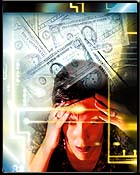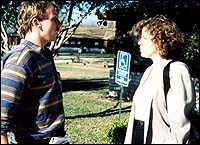

 How a billion-dollar
How a billion-dollar
cross-border psychiatric
scheme is feeding off
victims of tragedy
by Andy Prough & Catherine Malone
Special to Freedom

n March 1995, the Clinton administration launched "Operation Restore Trust," a law enforcement initiative to clean up health-care fraud. In its first year, it recovered $42 million; in its second, the figure had grown to $1.2 billion. Now in an unprecedented fourth year, the program's success has earned it expanded federal funding and resources as it moves into its next phase.
But the stunning quantum of funds recovered by Operation Restore Trust is more a cause for alarm than it is for satisfaction, for it offers a sense of just how widespread and unchecked health-care fraud has been.
Indeed, to paraphrase one Justice department analyst, there is a universe of fraud only now being uncovered. The April 6 announcement of the filing of an extraordinary $175 million federal lawsuit in Madison, Wisconsin, against Tenet Healthcare by Canadian officials is, as one attorney put it, "only a start."
The facts underlying that suit bring the connection between events in Canada and in the United States into sharper focus. In late 1997, Freedom's Canadian correspondents brought to light the story of the largest case of health-care fraud in Canadian history. Thousands of Ontario citizens had been funneled into U.S. psychiatric hospitals at an estimated cost of $400 million to the taxpayer-funded Ontario Health Insurance Plan (OHIP). It was also revealed that U.S. psychiatric hospitals hired "patient brokers" or "bounty hunters" to secure patients through misleading marketing practices and fraudulent means, resulting in patients being incarcerated in costly psychiatric hospitals. Some patients were sent for "smoking addiction," and others for "weight loss."
In this issue, Freedom presents the results of a 12-month investigation by the Citizens Commission on Human Rights (CCHR) and Freedom, in conjunction with Brabant Newspapers of Canada. It is the story of the insured and incurable — brain injury survivors, who've become human cogs in a multi-million dollar cross-border psychiatric scheme.
To fully understand the nature of this tale, one must know that the Attorney General of Ontario, Canada took the unprecedented action of filing a $130 million lawsuit against 36 U.S. psychiatric hospitals in April 1997, after CCHR exposed fraud and abuse involving Ontario residents. Five years earlier, in 1992, the FBI had raided hospitals owned by National Medical Enterprises (NME) — the same company named in the Canadian suit. The investigation of NME resulted in a $380 million settlement.
 In the summer of 1990, an intensive congressional investigation was launched into the "brain injury rehabilitation" industry. At the same time of that investigation, Lynn, Massachusetts-based New Medico, a chain of rehabilitation facilities which was once the largest U.S. network of brain injury rehab clinics, was also the target of an FBI probe.
In the summer of 1990, an intensive congressional investigation was launched into the "brain injury rehabilitation" industry. At the same time of that investigation, Lynn, Massachusetts-based New Medico, a chain of rehabilitation facilities which was once the largest U.S. network of brain injury rehab clinics, was also the target of an FBI probe.
One of the driving forces behind the investigation was brain injury survivor Lucy Gwin of Rochester, N.Y., today one of the leading voices for the rights of the disabled in the United States. Her harrowing experience at a brain injury rehabilitation facility owned by New Medico left her so outraged she was moved to document the cases of hundreds of brain injury survivors. Her findings, corroborated by government investigations and evidence obtained by Freedom, reveal an alarming pattern of human rights violations on American soil — all for a profit.
Lucy Gwin never knew what hit her — literally. After working as a professional writer for years and raising two daughters, through the reckless actions of another, her life was irrevocably changed.
In 1991, she was hit by a drunk driver in a downtown intersection. The police were called but, because of traffic delays, the driver escaped from the scene, never to be found. She was rushed by ambulance to a hospital where she remained unconscious for three weeks. When she awoke she was taken to the New Medico rehabilitation facility in Cortland, New York. Soon after her arrival Gwin walked outside to smoke a cigarette. "This place is nothing but a prison," were the words she heard uttered by another patient as she stood outside.
The next morning, she awoke to the screams of her roommate, who was taking a shower "assisted" by staff. A cheery social worker, speaking slowly, told Gwin she would work to make her stay "very happy."
For weeks, Gwin wandered the facility, making mental notes of abuse against patients including the rape of her roommate by three staff members, watching a patient receive kicks to the head for trying to leave and psychiatric drugging of patients who questioned their "treatment."

| ||
| Brain injury survivor Lucy Gwin: “That’s when the vultures came.” |
Despite the widely held contentions of psychiatrists and psychologists behind brain injury rehab, survivors like Lucy Gwin do remember the abuse they suffer. Indeed — and unfortunately for New Medico — the memories of Gwin and other patients are crystal clear.
"Most of us believe that when people are hurt, no one would take advantage of them," says Gwin, who now works as a journalist in New York. "Wrong. That's when the vultures come."
Gwin said that during her three-week stay, patients spent their days sitting "outside at picnic tables, smoking." When she confronted the staff about their physical abuse of other patients, she was put in a "baskethold," a restraint similar to a Full Nelson wrestling hold, leaving the patient completely immobile. "It's one of the most evil things you can do to a person," said Gwin. "It's terrifying."
Her insurance was billed for substance abuse treatment even though she didn't have a substance abuse problem. Incredibly, New Medico, the largest chain of rehabilitation facilities in the U.S. at the time, justified the billings on the basis that the driver who hit Gwin was a drunk. New Medico billed Gwin's insurance $10,000 U.S. for seven days of treatment.
Charges against New Medico, covered in a congressional report entitled "Fraud and Abuse in the Head Injury Rehabilitation Industry," included, "inappropriate care, fraudulent billings, misleading marketing practices and the use of non-skilled workers." Other allegations included "unethical recruitment of patients, virtually non-existent medical treatment, falsifying treatment records to show improvement to families, referral fees paid to hospital personnel and patient quota."
The congressional probe heard that New Medico was charging $2,000 per patient per day, which were hospital rates for nursing home services worth only a maximum of $200 a day, according to the testimony of former New Medico medical director Dr. Kenneth Hoelscher.
|
Ed De Martino was a maintenance worker turned health care aide at New Medico's Cortland, N.Y. facility. Ironically, two years after getting the job at New Medico, De Martino's son WayneJohn became severely brain injured after being hit by a drunk driver.
The De Martino family lived only a few blocks away from the former New Medico facility. As a staff member and parent, Ed De Martino said he witnessed fraudulent psychotherapy on brain injured patients, pressure on staff to keep patients for as long as possible and mass billings for non-existent or useless treatment.
"There was a psychiatrist who would come in and put all the brain injured patients in the gym and kick the ball around for a few minutes," he said. "He billed everybody's insurance all at once for group psychotherapy."
According to De Martino, in order to submit bills to Medicaid, New Medico would fly a psychiatrist in from another state, put him up in a hotel for several days and have him fill out invoices in the facility's gymnasium on patients he had never even met.
New Medico hired college students to help commit patients who were questioning treatment to a nearby psychiatric hospital in Binghamton, N.Y. There, De Martino said, New Medico would attempt to get legal guardianship in order to access the patients' assets.
But some of the worst abuses of patient rights were committed against his own son. During one of her daily visits, Mrs. De Martino was told by staff that her son was "all cleaned up" for her visit. When she pulled the blankets down, WayneJohn was covered in excrement.
"My son wasn't fed anything but water for 21 days and went from 191 to 100 pounds," said Mrs. De Martino. "This was the most extreme case of gross neglect I've ever seen."
While in the facility, their son also was put on 20 different psychiatric drugs including Haldol and Chlorpromazine. The De Martinos' family doctor ordered that WayneJohn be taken off every drug except one.
While in the facility for one year, WayneJohn received physical therapy only twice, which led his limbs and joints to atrophy. According to De Martino, the facility had only one rehab therapist on hand for 80 or more brain injured patients.
When the De Martinos complained about their son's treatment, New Medico sought to send WayneJohn to a New Medico facility in Massachusetts because the company could have billed Medicaid 50% more money for out of state patients — upwards of $2,000 per patient, per day. The De Martinos refused and told New Medico they would take their son home and care for him there. New Medico officials responded by stating the parents were misguided and "in denial" for wanting to care for their son at home at no cost to Medicaid.
Violence and "confabulation"
Six years after that congressional investigation, taxpayers in both the United States and Canada should be more than a little concerned that the brain injury rehab industry is still a thriving, multi-billion dollar business — and that its corruption seems to know no national boundaries. Powerful lobby groups like the Brain Injury Association in the United States (formerly the National Head Injury Foundation) and the Ontario Brain Injury Association (OBIA) have successfully convinced government agencies and health insurance providers that brain injury is not a disability; rather, it requires a lifetime of expensive psychiatric "treatment."
In brain injury rehab, beatings are termed "restraints," psychiatric drugging is called "treatment" and claims of abuse by brain injury survivors are dismissed as psychotic ramblings.
One who dismissed the results of CCHR's and Freedom's Canadian investigation was psychologist Dr. Barry Willer, professor of psychiatry at State University of New York at Buffalo. Willer denied claims of abuse by former Ontario patients who were hospitalized at a Texas facility called Tangram Rehabilitation Network.
But it is more than likely that Willer's indignance stems from his documented connections with the principals of the Brain Injury Association, including Tangram's owner, neuropsychiatrist Stanley Seaton. Willer is also the consulting psychologist at Anagram, an Ontario brain injury facility, which, by Willer's own admission, is modeled after and closely connected to Tangram.
"These rehabilitation programs were considered the most effective by the international rehabilitation community," said Willer.
Yet in 1996, when it suited Willer, he appeared on a national Canadian television show, CBC's "The Fifth Estate," to attack the former director of a hospital-based brain injury program which was moving in on Willer's turf. Within months of Willer's volley, the director was discredited and Willer was made director of the Ontario Brain Injury Association. Since then, Willer has become the leading advocate of the use of U.S. rehab facilities for Canadian patients.
Willer, who describes himself as one of the foremost experts on brain injury in North America, claims that brain injured patients' recollection of abuse at Tangram could be "confabulation": "In the absence of good memory, an individual with brain injury will often rely on the cues of others to develop their answer to a question. Individuals with dense memory problems not only confabulate but once they generate a confabulation (which is generated to replace real memory, not a dishonest act), the confabulation becomes as real as any actual memory would be."
Yet numerous brain-injured patients treated at Tangram had no difficulty recounting, in detail, many startling incidents of abuse at the facility over a five-year period. And once CCHR made public its Tangram investigation, the facility came under criminal investigation by the Texas Department of Human Services for alleged abuse of patients.
The case is being handled by the Guadalupe County District Attorney's Office, which on April 2 and May 7 appeared before a Grand Jury and obtained criminal indictments against a total of three Tangram staff members, one of them the manager of Tangram's eight facilities. As a result of the cooperative efforts of the Human Services department and CCHR, the Attorney General of Texas filed a civil suit against Tangram on May 12 for abuse and failure to report abuse. Millions in fines against Tangram are sought.
For its part, Tangram vehemently denies any abuse against patients and stated it takes allegations of abuse "very seriously."

| ||
| A “daily planner“ for brain injured patients at Tangram. |
A veteran Tangram staff member told Freedom that she witnessed physical abuse of patients, falsification of clinical records, use of unlicensed staff and extensive, even wanton use of psychiatric medications.
The whistleblower, who asked that her identity be protected for fear of retribution, said that the physical abuse of patients was extensive: "Right before Thanksgiving, a client who was never self-abusive came in with a black eye, swollen ears and all black and blue. He said a staff member had put an elbow into his eye and pulled and twisted his ear. It was nothing but abuse."
She added that she has been encouraging her peers to speak up. "I told them you're either part of the solution or you're part of the problem and if they've witnessed abuse, they need to start telling it. I'm not lying for anybody and I'm not going to jail for anybody."
Other reported incidents include an employee brutally slapping a patient in the face and another where the side of a patient's face was smashed so viciously that it almost caused permanent eye injuries. The victim was promised a shopping trip by a Tangram executive in exchange for his silence about the incident.
Incident reports, which are required to detail injuries suffered by patients during restraints were routinely changed or omitted from the patients' file, said the whistleblower. Fictitious accidents are reported to cover up injuries suffered by patients, she said. "You'll write up the report and they'll go behind you and say, why don't you reword it to make it look more professional and make it so that no legal action can ever be taken against Tangram."

| ||
| Victim Robbie Thompson (with physician Dr. Moira Dolan): “A review of Robbie’s Tangram file shows that injuries suffered during restraints may have been covered up with accident reports.” |
Injuries covered up
One Canadian patient sent to Texas' Tangram facility was Robbie Thompson, who was flown there in late 1992 without his parents' knowledge or consent. Based on the latest daily rate being charged for Thompson's treatment, his five year stay at Tangram cost taxpayers an estimated $1.2 million.
"A review of Robbie's Tangram file shows that injuries suffered during restraints may have been covered up with accident reports," said Dr. Moira Dolan, a physician who reviewed Thompson's case at the request of his parents. For example, a December, 1995 accident report stated that Robbie fractured his finger falling in his room.
"With the location of that fracture, it's what we call medically a boxer's fracture," said Dolan. "That means it's the type of fracture you get when you defend yourself. For this type of fracture to happen from falling is just not believable."
The Tangram whistleblower reported that staff who questioned the abuse were ostracized and harassed. "If you're not in the clique, you're in trouble. When you start questioning what you've seen, you're an outsider."
Dolan told Freedom that Tangram's assessment of Thompson is rendered highly suspect when viewed in light of information provided by Robbie's parents, a former Tangram employee who worked with Thompson, and her own examination of him. Robbie's parents reported that during a year-long stay with them, their son never exhibited a behavior problem nor made threats or gestures of harm toward himself or anyone else.
"The progress notes frequently stated that, while Robbie continues to show improvement, he still needs a great deal of assistance, direction and behavior management," said Dolan. "This is incongruous with the noted abilities to teach others how to program a complex computer-watch, assist visually impaired patients and accurately recall 80% of his day."
Lining up for drugs
While there is a neurologist associated with Tangram who periodically examines patients, for several months the facility did not have a single nurse on its payroll. A Tangram staff member added that staff receive a scant 60 hours of training to work with patients. Staff also perform duties which, according to that employee, should only be done by trained medical personnel. She cited as an example that all patients line up at breakfast, lunch and dinner for their medications, many of which are psychotropic or mind-altering drugs. The medications are prescribed primarily by Tangram's owner, Dr. Stanley Seaton.
But Dr. Vikki A. Stefans, Medical Director of the Acute Rehabilitation Unit, Arkansas Children's Hospital, said Tangram's liberal use of psychotropic medications is "wildly inappropriate." "By and large," she said, "the anti-psychotics like Haldol and Mellaril have a slightly higher risk of side effects in people with brain injuries. Anti-psychotics for everybody is bad." Freedom also found that Seaton admitted under oath to using unlicensed physicians to conduct medical evaluations of patients at Tangram, which, according to legal experts, could leave Seaton open to fraud charges.

Twenty-six year-old Craig Collings from Ontario spent five years at Tangram and said that Tangram was essentially nothing more than a psychiatric facility in the guise of a brain injury rehabilitation clinic where patients' rights were routinely abused. "If you come at a person who's agitated, what's going to happen? They're going to come at you because they feel threatened. When patients would feel threatened and try and defend themselves, it always resulted in a restraint."
Like Thompson, Collings said he was also physically abused, that patients were restrained excessively, that patients were given "all kinds" of medication and that Tangram patients did nothing but work from early morning until evening.
Restraint
There are also serious questions concerning the right of Tangram to force any brain-injured adult to be held against his or her will. Tangram's brochure states that only patients who are "not a danger to self and/or others" are admitted for treatment.
Yet according to Tangram's patient consent forms, Tangram reserves the right to "hold clients on the premises of Tangram by any reasonable means and/or for a reasonable time period although said holding and/or restraint may be against the expressed desire of client."
Texas attorney Martin Cirkiel, who specializes in health fraud cases, reviewed the consent forms from Tangram. "A competent adult could consent to just about anything. The issue here is can a brain injured person really give informed consent. This kind of fraudulent treatment is an outrage," said Cirkiel.
Collings said if patients misbehaved, they were put "on isolation," which meant they spent hours working, often without a break, inside or outside the facility with no pay. When they were paid, it was under the program's token economy system, a form of money that can only be used at Tangram to pay for personal toiletries, outings or recreation.
As part of "vocational therapy," patients raised animals including chickens, pigs and cows until they were ready to go to the slaughterhouse. Patients were expected to work until they were exhausted. "The work was really tough," said Collings. "We were constantly on the go from the moment we got up until the moment we went to bed." He also witnessed degrading treatment of patients by staff.
One adult brain-injured patient from Pennsylvania would often wander away from the facility. In order to "know where he was" at all times, the staff attached cow bells to his shoelaces. "I thought that was going pretty far, it was pretty humiliating," said Collings.
Collings himself was also subject to acts of humiliation, according to a Tangram staff member. To punish Craig for trying to run away, his shoes were taken away from him for several days. In another incident, Collings had a rope tied around his hand which was attached to a Tangram employee. "They led him around like a dog," said the staff member. "To me, that was abusive."
For years, Collings was also told that Tangram was waiting for the Ontario government to bring him home. "I believe I could have gotten everything I wanted back in Ontario."
But that wasn't the way the industry was set up to run. One of the architects of the brain injury industry was "behavioral expert" Ahmos Rolider, formerly of the University of Kansas.
In 1989, Chedoke-McMaster Hospitals in Hamilton, Ontario, responsible for coordinating all Ontario brain injury services, hired Rolider to run its Centre for Behavioral Rehabilitation (CBR), a small, six-bed unit created to serve the severely brain injured population. Despite the fact that Rolider had little experience dealing with brain injuries, Rolider was promoted as a "miracle worker" with the brain-injured population.
Behind closed doors, Rolider was torturing patients, screaming at them and using techniques reminiscent of those used in the military for interrogation. This was done under the guise of "aversion therapy," with the full cooperation of the hospital, even though there was no proof of medical safety or effectiveness. One of Rolider's victims was Thompson, who was referred by him to Tangram in 1992.
Even more startling was that one of Rolider's key subordinates, outreach therapist Wayne Turner, traveled to Texas to export aversion therapy. Documents show that soon after Turner was assigned to monitor Ontario patients in the United States, he joined the payroll of Tangram and eventually became director of Tangram Ontario.
"All kinds of graft"
Dr. Steve Taylor, a professor at Syracuse University, Coordinator of Disability Studies and Director of the Center on Human Policy, is a staunch opponent of the brain injury rehab "industry."
"There are two kinds of rehab facilities: One is the greedy, private, for-profit corporations where there's all kinds of graft," he said. "Even if we eliminated all the graft and obvious corruption, still the basic problem is, in most states and provinces and certainly with our federal government here in the United States, there are strong incentives to put people with brain injuries away."

| ||
| One of the “group homes” used for brain-injured patients at Tangram. |
That certainly appears to be true in Robbie Thompson's case. A review of patient files showed OHIP received regular requests for "90-day extensions of funding" from Chedoke Hospital on behalf of Tangram to continue a patient's treatment. The requests are form letters and in Robbie's case, OHIP approved every request for 90-day funding extensions.
As a personal care facility, Tangram does not perform medical or surgical procedures and New Medico's facilities were former nursing homes converted into rehab centres.
Dr. Taylor said rehab facilities are nothing more than rest homes that have changed their names. "Based on what I do know, I personally consider rehab facilities — and this is not too strong a word — a scam. They're very expensive, glorified nursing homes."
A psychiatrically "created" field
Mr. Wilson Hulley, Executive Staff Member of the President's Committee on the Employment of People With Disabilities, is a brain injury survivor who said the field of rehab has been created by psychologists and psychiatrists. "It's easier for them to justify a person's rehab because they can do it from a 'creative' standpoint, as opposed to a medical standpoint."
Dr. Taylor said the kind of treatment given to brain- injured patients in institutions makes patients worse, not better.
"Now what happens when you put someone into an institution, is that the institution exacerbates any of those problems and creates a lot of those problems," says Taylor. "Within the institutional environment people are expected to be compliant. It goes back to 'One Flew Over The Cuckoo's Nest' and [Jack] Nicholson. It's that kind of thing. If the person doesn't conform to the rigid block treatment on the ward or unit, the response — and this is where institutions are especially dangerous — the response is to drug people up so that they become compliant."
Brain injury rehab is still big business. According to official estimates, there are at least 2,500 people who are severely brain injured in Ontario alone and each will cost at least $110,000 per year for their "treatment." This translates to an incredible $274 million in new business every 12 months. All of which could be summed up as a lot of money to invest with very little returns.
Brain injury is not a new problem. What is new is that the field has been taken over by profiteers, acting under the guise of medicine. According to Mike Boyd, a brain injury survivor from California who testified before a 1992 Congressional hearing on the brain injury rehab field, the psychiatric community "is running amok" and has taken over the field of brain injury, which has been completely subverted by psychiatric vested interests whose primary purpose is profit, not patient care.
Joe Ehman, a therapist in Denver, Colorado who has personally dealt with more than 200 cases of brain injury, says, "A lot of the so-called rehab can really be done on an outpatient basis and, what my experience has been, people who have survived injury — and survived rehab — basically all said the same thing: A lot of what they learned in rehab they really don't use in the real world."
Ehman says that the daily rates charged by facilities depend on the insurance policy of the patient — ensuring that profits are put before patients.
"When I am at this hospital for doing the re-entry program, they push the people to come back in six months to a year for re-evaluation, to see if any functioning has changed with bladder, bowels, muscles, nerves, and that sort of thing and maybe there's a need for it, but the first question they ask the people is 'What is your insurance company?' It's just a money maker. This is right now, this is today."
In Texas, CCHR is working with state senator Michael Moncrief to craft legislation which will set new, humane standards for brain injury rehabilitation. And north of the border, government officials are finally at the end of their rope, taking the extraordinary step of filing litigation in the United States to recover misappropriated funds. On April 6, Ontario Health Minister Elizabeth Witmer announced that the province had filed suit in Madison, Wisconsin against the California-based Tenet Healthcare and its former subsidiary, National Medical Enterprises, seeking $175 million in damages. One U.S. legal analyst noted that such a suit shows extraordinary concern. "This looks like a strong case," he said, "but lawsuits like these are generally seen as too great a risk and are rarely brought — a foreign government suing major corporations in another country. It suggests a strong commitment from the Canadians." Such commitment from federal U.S. authorities is overdue.
It is long past time for the U.S. Department of Justice to launch a full investigation into those who have created or allowed a brain injury "system" which is merely a cloak for widespread fraud and abuse.

